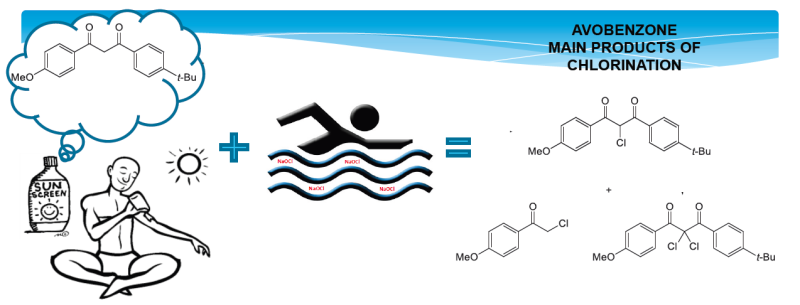Sunscreen creams break down into dangerous chemical compounds under the sunlight

Scientists from the Faculty of Chemistry of the Lomonosov Moscow State University have demonstrated in their research the nature of hazardous chemical compounds formed as a result of the breakdown of avobenzone, a component of many sunscreen products, when it interacts with chlorinated water and ultraviolet radiation. The chemists have presented the results in the Chemosphere journal.
The chemists studied avobenzone, a derivative of a chemical compound called dibenzoylmethane. Avobenzone is the most popular UV filter in the world. It was patented in 1973, and in 1988, approved by FDA in the United States.The ability of avobenzone to absorb ultraviolet light in a wide range of wavelengths has ended in its widespread use in lipsticks, creams and other cosmetics.
Sunscreen products containing avobenzone are used all over the world. Chemical UV filters like avobenzone absorb ultraviolet light due to peculiarities of their structures. Absorbing ultraviolet radiation, avobenzone translates it into other wavelengths that aren't harmful for the skin—in other words, it translates energy of light into thermal energy. Thus, although the substance is safe, the Russian scientists have proved that in water solution, it's capable of breaking down into hazardous chemical compounds.
The scientists from the Lomonosov Moscow State University have defined the products formed as a result of the breakdown of avobenzone in chlorinated water and under the sunlight. These experiments simulated the real situation in which a sunscreen is applied to the skin of swimmers. They hypothesized that the breakdown of avobenzone may take place on wet human skin.
The chemists discovered that avobenzone breaks down in the water forming organic compounds belonging to the classes of aromatic acids and aldehydes, phenols and acetyl benzenes. Phenols and chlorinated acetyl benzenes are the most toxic products. Acetyl benzenes, particularly chloracetophenone, enter into the composition of lachrymatory mixtures used in products like tear gas.
Chemist Albert Lebedev, one of the project authors, says, "On the basis of the experiments, one could make a conclusion that a generally safe compound transforms in the water and forms more dangerous products. In spite of the fact that there are no precise toxicological profiles for the most established products, it's known that acetyl benzenes and phenols, especially chorinated ones, are quite toxic."
The researchers used chromato-mass spectrometry. This reliable method allows conducting qualitative and quantitative analysis of the most complex mixtures of chemical compounds. Albert Lebedev says, "Studying the products of transformation of popular cosmetics is very important, as they often turn out to be much more toxic and dangerous than their predecessors."
At the moment, the scientists are studying the transformation of avobenzone under conditions of chlorination and bromination of fresh and sea water. During chlorination or bromination of sea water, the number of the breakdown products of avobenzone will be even wider. And if water contains copper salts (which are added into swimming pools to produce light blue coloration), then bromoform is formed in large quantities. This substance could provoke dysfunction of the liver and kidneys, along with nervous system disorders.
More information: Cheng Wang et al, Stability and removal of selected avobenzone's chlorination products, Chemosphere (2017). DOI: 10.1016/j.chemosphere.2017.04.125
Journal information: Chemosphere
Provided by Lomonosov Moscow State University


















